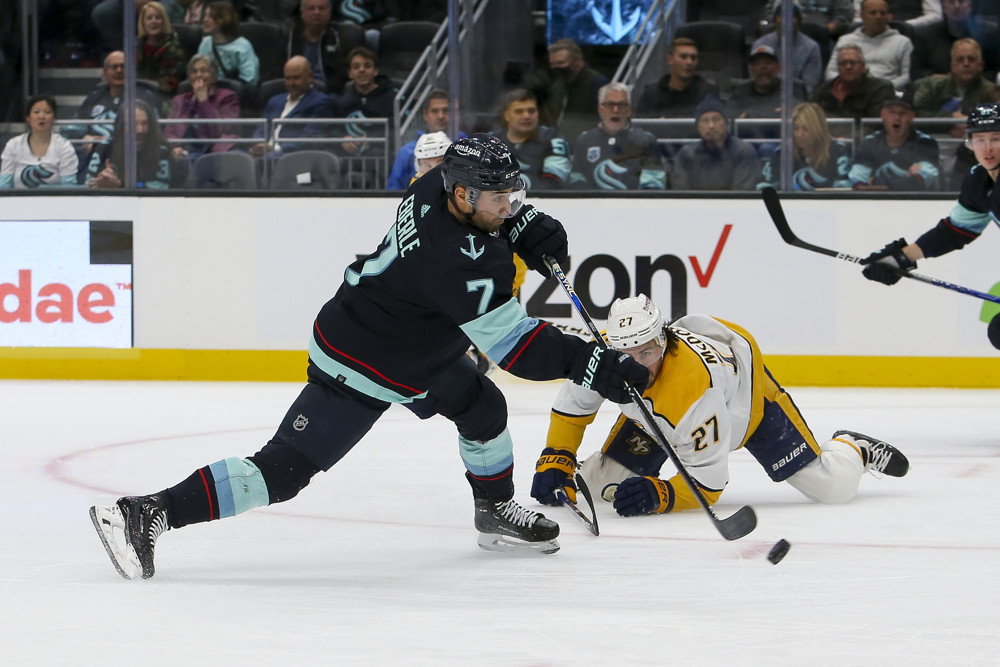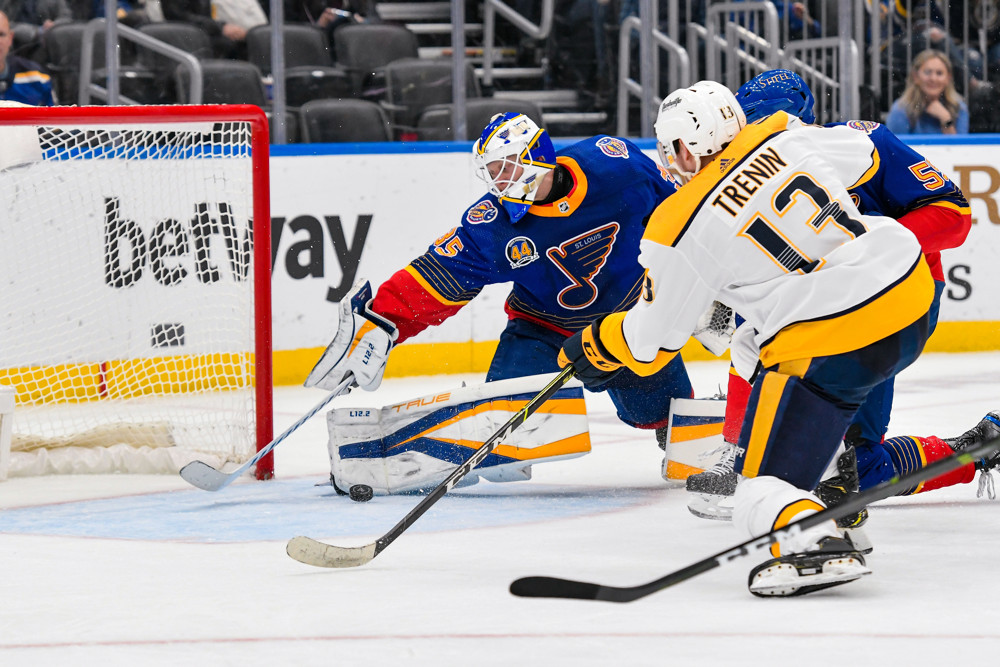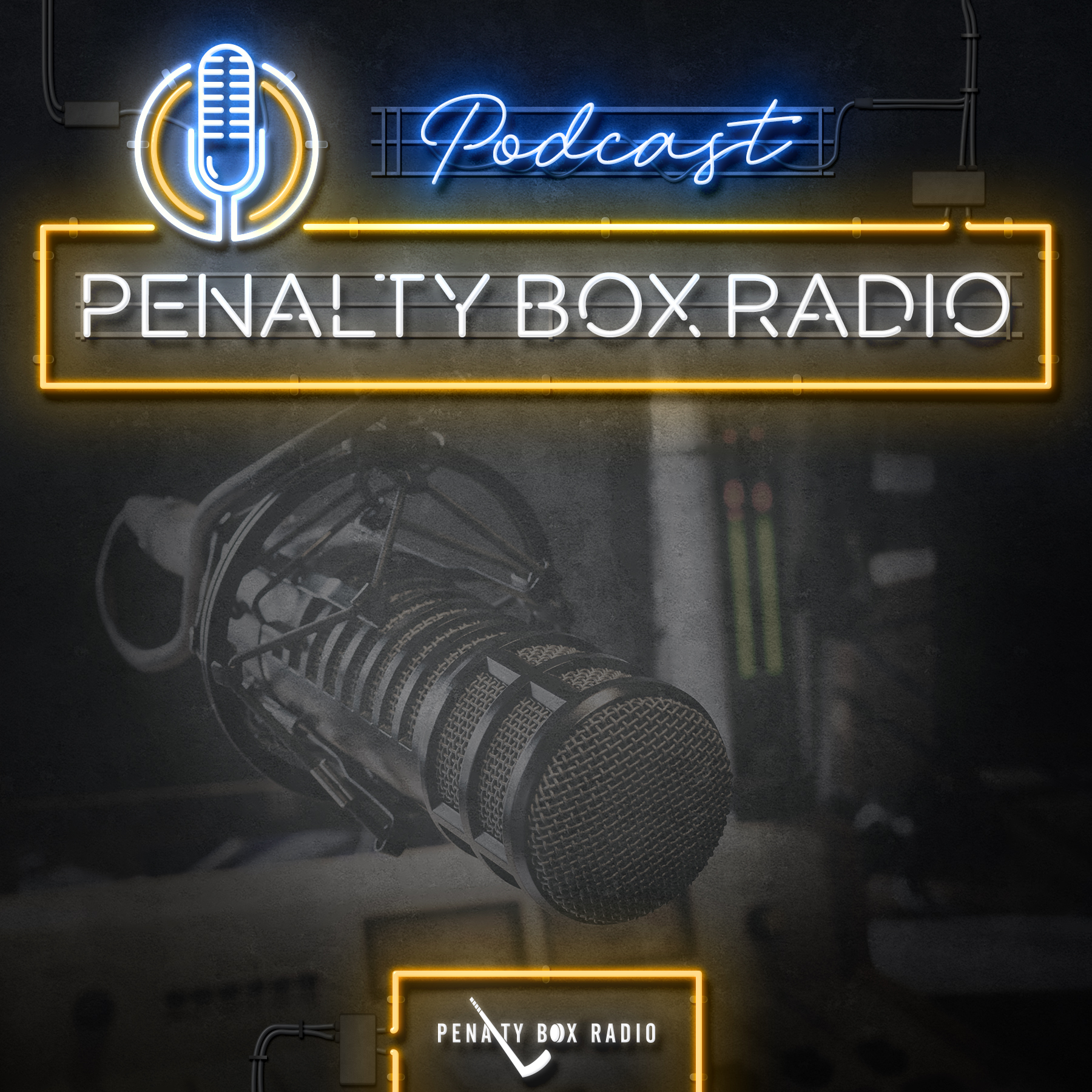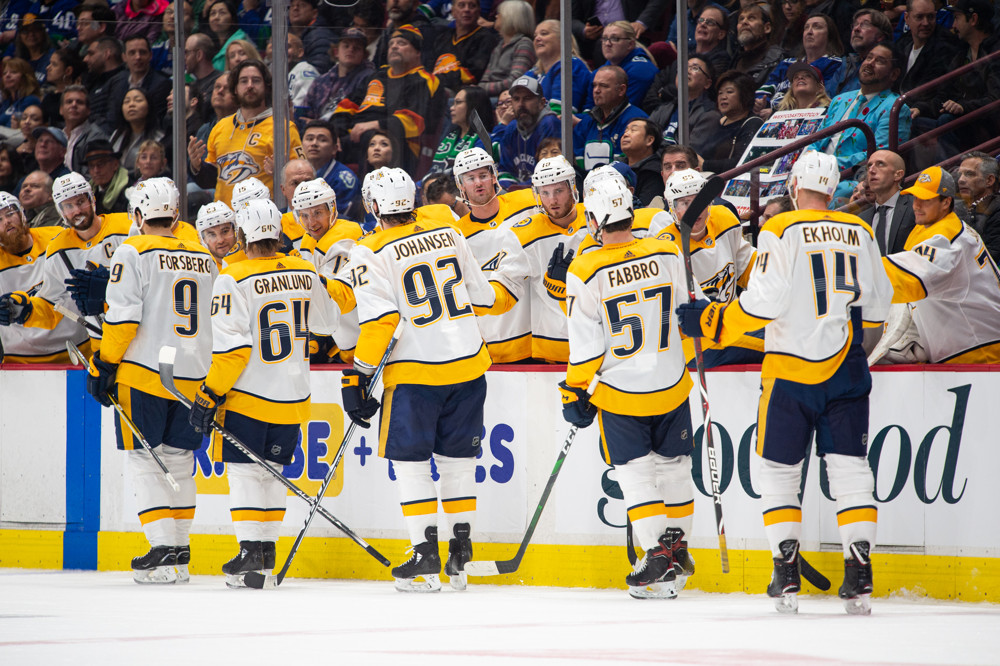 Here we are, November 27th, the day that statistical analysts dream of. It’s that long-awaited mark where we can finally start to identify trends without a million other people yelling in our ears about the sample size. It truly is a magical day, so let’s celebrate with a look into how exactly the Nashville Predators are doing in their first 24 games or so.
Here we are, November 27th, the day that statistical analysts dream of. It’s that long-awaited mark where we can finally start to identify trends without a million other people yelling in our ears about the sample size. It truly is a magical day, so let’s celebrate with a look into how exactly the Nashville Predators are doing in their first 24 games or so.
The Predators are currently tied for first in the NHL with 35 points, and I think most fans would agree it’s been a great start to the season. But how exactly is Nashville coming into these wins? Is this pace sustainable, and how much regression can we expect? Let’s dive in with some of the simple stuff. All stats below are at five on five unless explicitly stated otherwise, and there’s a sample size of at least 13 games, so Viktor Arvidsson made the cut, but guys like Austin Watson will not be mentioned. All stats are verified as of Sunday the 25th at 11:30 PM, Central time.
 Shots, And Things Of That Nature
Shots, And Things Of That Nature
In terms of quantity, the Predators are a top 10 squad. Being a top Corsi or Fenwick team doesn’t guarantee a playoff spot, but pretty much everyone agrees that the best, and most sustainable teams are above that 50% mark for most shooting stats. For the uninformed, Michael Wade and I wrote a shooting stat primer here, but for the lazy, Corsi is shot attempts and Fenwick is unblocked shot attempts. The general idea is that shot attempts are a reasonable way to measure possession as you must have the puck in the offensive zone to take a shot attempt. It’s flawed and doesn’t tell the whole story, but it’s a fine starting point.
The Predators rank seventh in the NHL for Corsi with 51.82% and seventh in Fenwick with 51.94%. Things start to drop a bit when we look at their overall shot share, but not by much. The Predators are currently mustering a 50.89%, good for 12th in the league.
So what’s causing these top half of the league numbers? Is it their offense or defense? Let’s find out. Because not every team has played the same amount of games, we’ll be using per 60 stats to create averages for the entire league.
 I’m going to spoil the answer to the question I just posed, it’s definitely not the offense. The Predators are currently creating the 15th most shot attempts per game with 57.13. They’re about 15 shot attempts worse than league leader, the Carolina Hurricanes. Nashville’s unblocked attempts also rank 15th most, as they produce 43.53 per game.They’re at least a bit closer to the, once again, league-leading Hurricanes who produce 53.82 unblocked attempts. All of this culminates in the Predators creating 31.06 shots per game, good for 16th most in the NHL. Their overall offense is pretty much average.
I’m going to spoil the answer to the question I just posed, it’s definitely not the offense. The Predators are currently creating the 15th most shot attempts per game with 57.13. They’re about 15 shot attempts worse than league leader, the Carolina Hurricanes. Nashville’s unblocked attempts also rank 15th most, as they produce 43.53 per game.They’re at least a bit closer to the, once again, league-leading Hurricanes who produce 53.82 unblocked attempts. All of this culminates in the Predators creating 31.06 shots per game, good for 16th most in the NHL. Their overall offense is pretty much average.
Craig Smith remains the best shooter on the Predators, as he produces 11.65 shots per 60 minutes played. That averages to about two shots per game when we remember that he plays around 12 minutes per night. Viktor Arvidsson (10.41) and Filip Forsberg (10.29) make up second and third place, respectively. These three fill up first, second and third for individual shot attempts and individual unblocked shot attempts as well. The rest of the Predators are kind of lackluster, no other Predator creates more than 7.83 shots per 60 minutes. While the top three lead the league, the bottom nine are average at best. Let’s move on from the bad, and see how the Predators make up the difference.
 The defensive side of the puck is where the Predators are shining so far. The Predators are surrendering the third fewest shot attempts per game with 53.13. When only counting unblocked shot attempts against, the Predators are a little bit worse. They’re the fifth best team with 40.28 unblocked attempts against per game. Unfortunately, things once again take a turn for the worse when we just look at shots. The Predators fall to 11th fewest shots against with 29.98 per game, but that’s only about two shots from fourth fewest and 5 shots from first.
The defensive side of the puck is where the Predators are shining so far. The Predators are surrendering the third fewest shot attempts per game with 53.13. When only counting unblocked shot attempts against, the Predators are a little bit worse. They’re the fifth best team with 40.28 unblocked attempts against per game. Unfortunately, things once again take a turn for the worse when we just look at shots. The Predators fall to 11th fewest shots against with 29.98 per game, but that’s only about two shots from fourth fewest and 5 shots from first.
Mattias Ekholm and P.K. Subban lead the charge in terms of not allowing shots. Ekholm surrenders 26.77 per 60 minutes played, while Subban gives up 27.25 In terms of average, the duo gives up a little more than 9 or so shots per game. That’s pretty incredible when you remember that they regularly face top NHL competition with no offensive zone sheltering. Ryan Ellis does a pretty decent job, as he gives up 30.43 shots per 60. But that’s still better than Roman Josi, who surrenders 31.96 shots per 60 while playing hockey according to the definition of fun. The defensive Corsi and Fenwick results look almost identical to the shot numbers, as Subban and Ekholm continue their dominance.
Overall, the Predators ability to not concede shots is what’s keeping them afloat. The offense needs to be able to create more if the Predators would like to give their defense and goalie a break. Though, this begs the question, what if the offense is more focused on quality over quantity?
 So You’re Saying There’s A Chance
So You’re Saying There’s A Chance
So I might’ve gotten your hopes up for nothing. Nashville doesn’t really care about creating quality scoring chances. Yes, the Predators still have a 50.59% share of the scoring chances on the ice, but that’s only good for 14th in the NHL. Their high danger chance share is where things really start to get off the rails, the Predators only control 49.48%, good for 18th most in the league.
The offense is, once again, the culprit in how the Predators are not winning the scoring chance battle. They’ve only produced 473 which ranks 13th in the NHL. Right between the New Jersey Devils and Dallas Stars, two teams not known for their offensive prowess outside of their top lines. Now, the divide between 13th place and the top 10 isn’t that large, only 25 or so chances, but the Predators are not exactly trending upwards in this regard.
 Things actually get a little better as we look deeper into high danger chances. The Predators rank worse, 20th overall with 189, but they’re less than 30 outside of the top 10.While the offense isn’t doing enough to put the Predators in a sustainable spot to win, the door hasn’t closed on them either.
Things actually get a little better as we look deeper into high danger chances. The Predators rank worse, 20th overall with 189, but they’re less than 30 outside of the top 10.While the offense isn’t doing enough to put the Predators in a sustainable spot to win, the door hasn’t closed on them either.
Ryan Johansen has created 24 high danger chances so far this season, which leads the team by three and places him tied for 35th in the entire league. Filip Forsberg follows with 21, while Craig Smith once again rounds out the top three with 20. Fiala follows along pretty quietly with 19.
Arvidsson still leads in terms of high danger chances per 60 with 5.55 per 60 minutes played, but this is due to his smaller sample size. Johansen comes in second with 4.31 per 60 and Sissons rounds out the top three with 4.19 per 60. I still believe that Johansen’s number is more impressive, as he has a larger sample size and faces much tougher competition than Sissons.
Now, onto where Nashville excelled. The Predators currently rank 10th fewest in the NHL with 462 scoring chances surrendered. That’s only 30 outside of fifth place. All this to say, the top 13 or so aren’t separated by much and the Predators are excellent just for being among these teams. The Predators drop a bit in terms of high danger chances, as they fall to 12th fewest with 193. That’s not too bad though, as it’s within 15 of fifth place.
 Once again, P.K. Subban and Mattias Ekholm are the best true defenders on the team. They gave up the fewest scoring chances per 60 of any defenseman. Ekholm gives up 23.60 while Subban surrenders 24.4 per 60. Yannick Weber predictably comes in at fifth place with 25.79 per 60, while Josi (26.29) and Ellis (24.62) continue their fun brand of producing a ton of chances while practically giving them away on defense. What’s weird is that while Josi and Ellis objectively play a more offensive based game, Ekholm and Subban are on the ice for more chances for and fewer chances against. After all, Subban and Ekholm are the only Predators in the sample size mentioned who have a scoring chance share above 51%.
Once again, P.K. Subban and Mattias Ekholm are the best true defenders on the team. They gave up the fewest scoring chances per 60 of any defenseman. Ekholm gives up 23.60 while Subban surrenders 24.4 per 60. Yannick Weber predictably comes in at fifth place with 25.79 per 60, while Josi (26.29) and Ellis (24.62) continue their fun brand of producing a ton of chances while practically giving them away on defense. What’s weird is that while Josi and Ellis objectively play a more offensive based game, Ekholm and Subban are on the ice for more chances for and fewer chances against. After all, Subban and Ekholm are the only Predators in the sample size mentioned who have a scoring chance share above 51%.
High danger chances continue to tell the story that scoring chances did. Ekholm and Subban lead with 9.38 and 9.76, respectively. Weber comes in fourth, 10.99, and Ellis, 10.51, and Josi, 11.48, round out the pack. It’s actually pretty surprising to see Weber ahead of Josi, but I think his assignments have something to do with it. Out of the five mentioned, Weber is the most sheltered with 55.28% offensive zone starts, and he regularly faces third and fourth line competition. It’s still weird to see Ellis and Josi below Weber in any stat, but it makes more sense when we look at the surrounding context.
Why Does This Matter?
If you’re some sort of sports nihilist who believes that nothing matters but the scoreboard, congrats on reading this far. You’re clearly a patient person and I appreciate you. But, if you’re a nerd or interested in numbers, these stats can mean a lot.
Shot attempts and high danger chances can be a valuable tool for the coaching staff. Do we really think producing these mediocre numbers are going to sustain how often the Predators are winning? The Predators are currently the third luckiest team in the NHL with a 101.9 PDO, mostly off the back of a collective 93.13 save percentage.
Peter Laviolette should see these numbers and address his style of play. Maybe don’t have your wingers stretching the opposition’s defense, and have them come a little lower to protect the slot. Maybe don’t have every shot go through the point, and instead have your skaters take on a more malleable structure than a three forward, two defenseman system. Allow Ekholm and Josi to attack the net and to charge headfirst into the corners. Having players move in the offensive zone will open up more chances in the high danger area, where goalies have a much worse save percentage.
I don’t want to complain too much, but why do the Predators love those point shots so much? Let your players move the puck around and establish meaningful possession through high percentage passes and quick board play. By focusing on moving the puck to high danger areas, the goals will come and your percentages will continue to grow.
Why does this matter? Because teams are currently watching the Predators and forming a plan to beat them over a seven-game series. By taking the majority of shots from the point and leaving the area in front of Pekka Rinne undermanned, the Predators playing right into their opponents’ hands.










